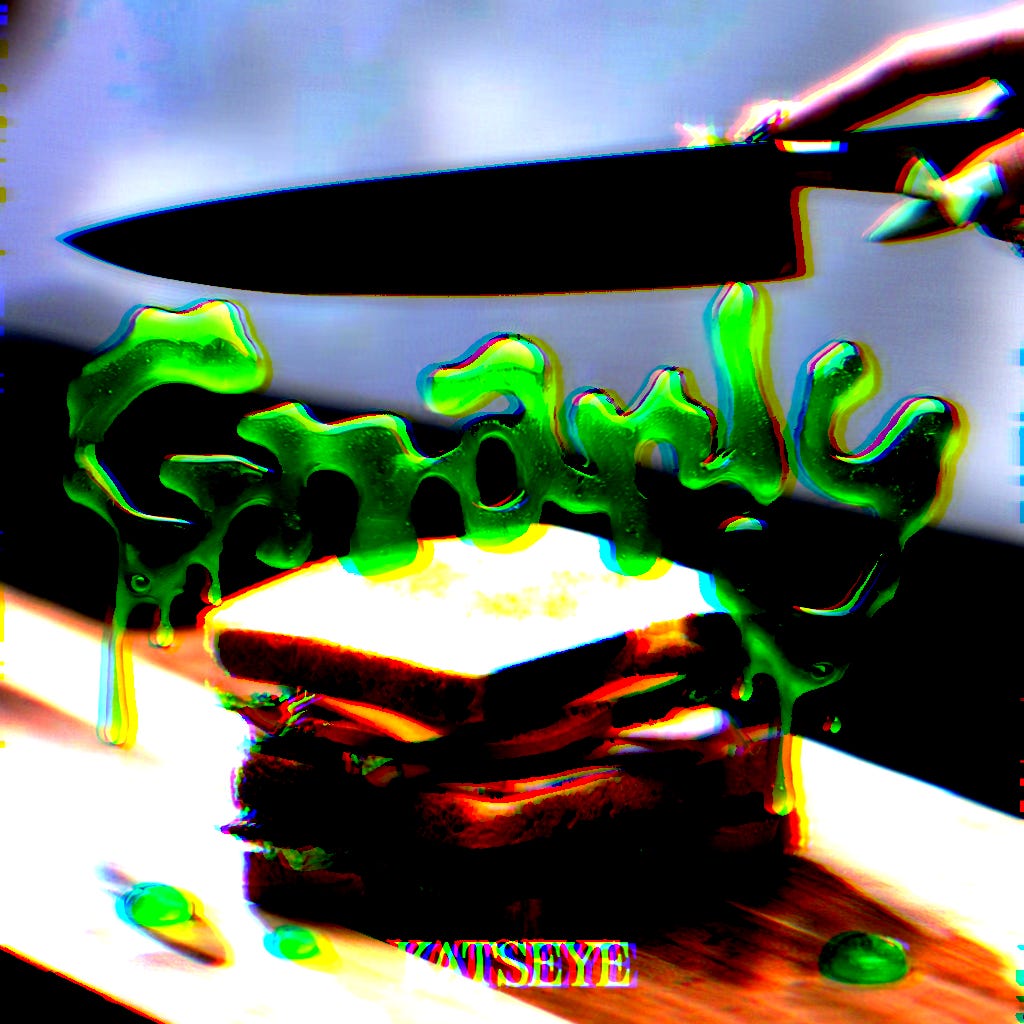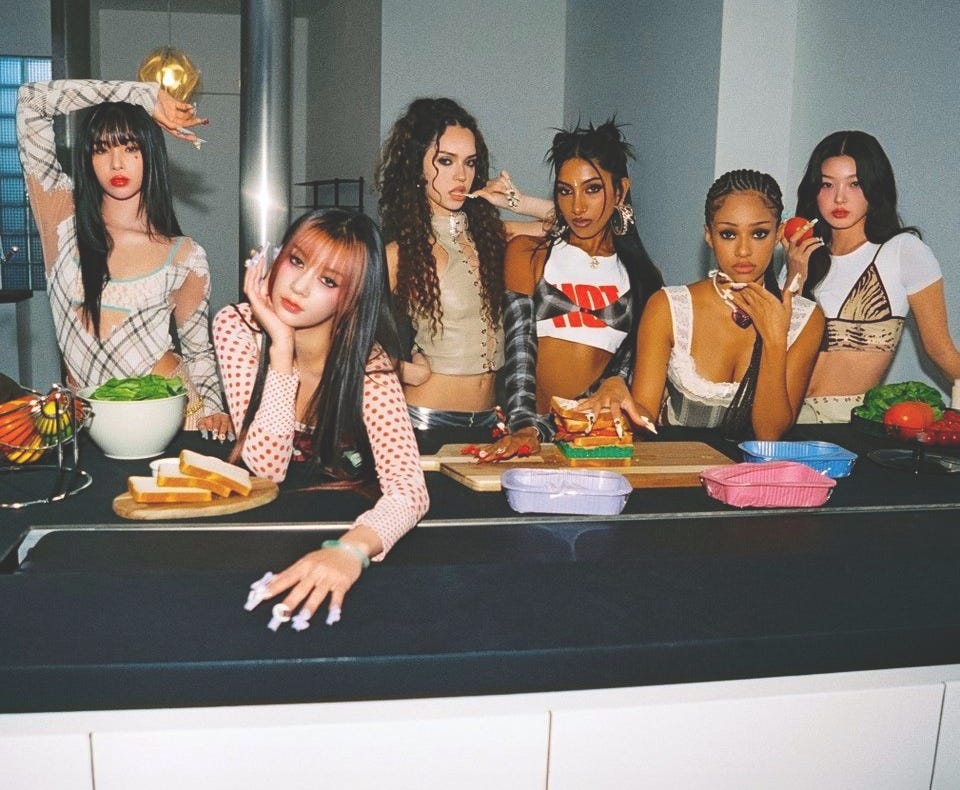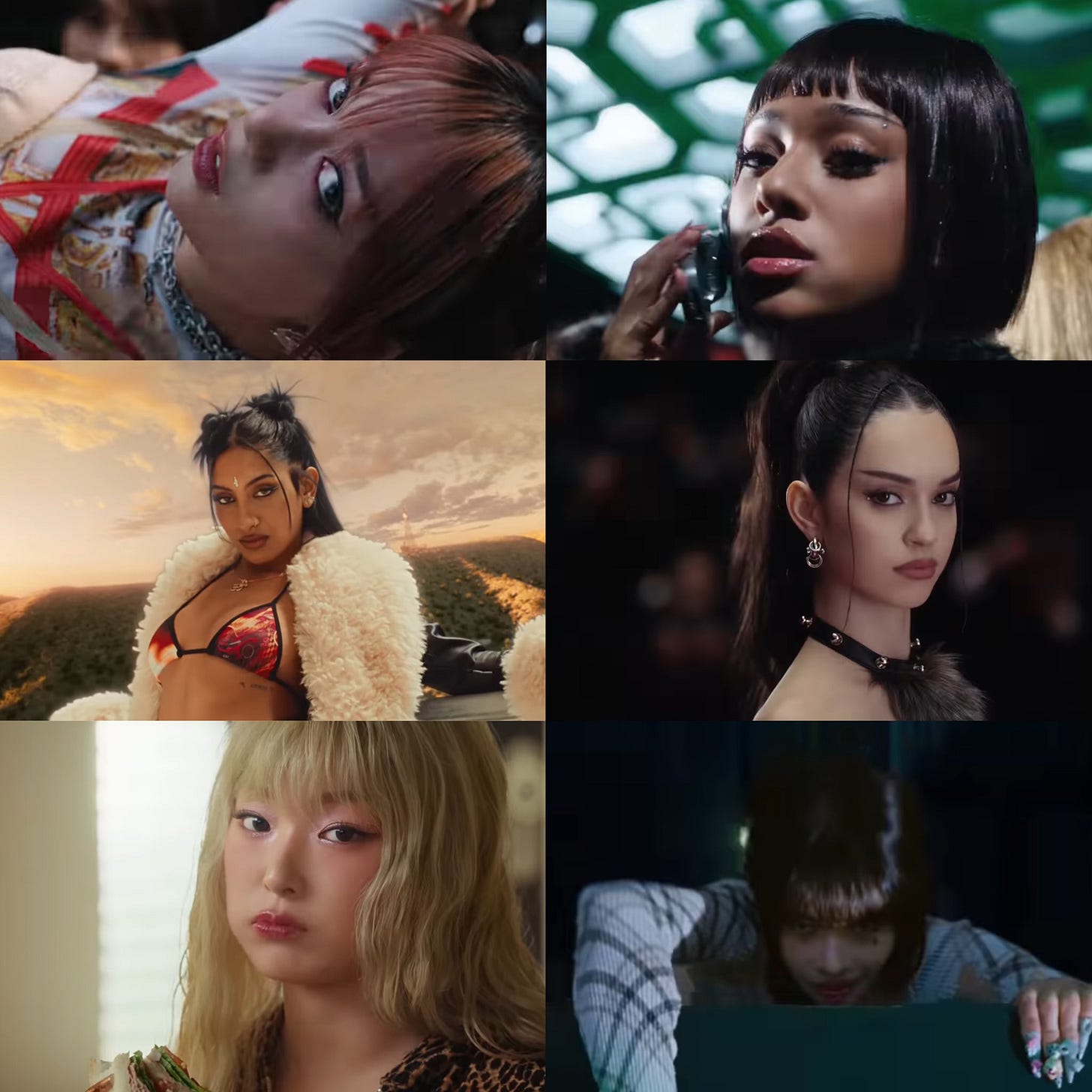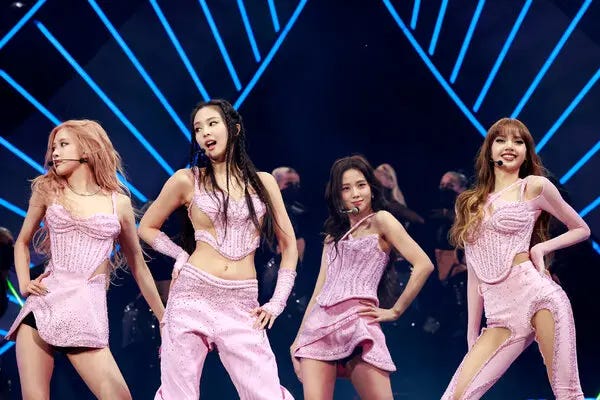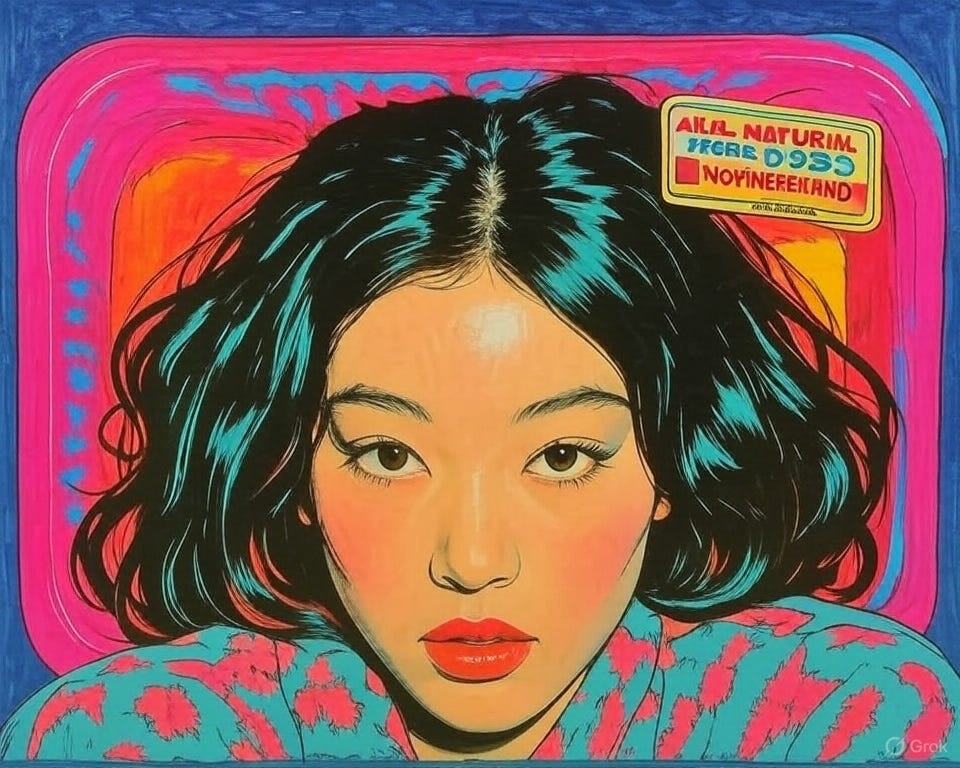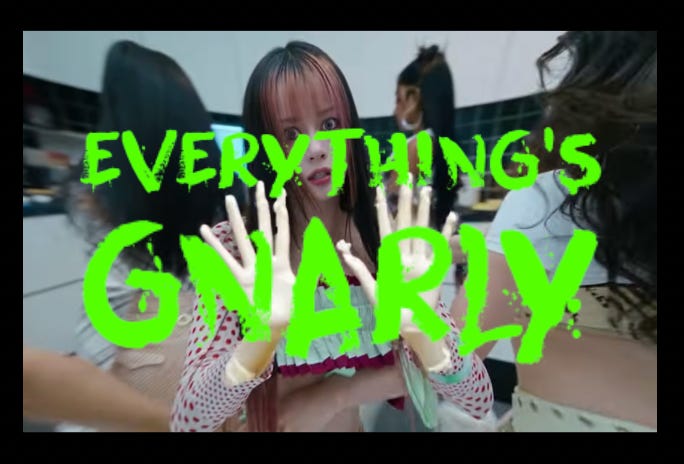EVERYTHING'S GNARLY
Global girl group KATSEYE serves spectacular zeitgeist-sizzle with a bubblegum bass song of the summer contender.
EVERYTHING’S GNARLY
The Recursive Spectacle of Gnarly: On the Mimetic Implosion of Hyperpop, and the Culture Industry’s Eternal Hunger for its Own Flesh
by DJ POOLHOUSE
GNARLY IS THE WORD
11 days ago, a girl group who goes by KATSEYE launched a public relations campaign for a record called Gnarly.
And judging by the explosive reaction from both the K-POP and hyperpop online communities, the impact of Gnarly is likely to ripple through the culture for many years to come.
Gnarly is undoubtedly the most striking, exhilarating, astonishing, and conceptually daring pop single of 2025.1
Gnarly is a toxic swarm, an audiovisual mind-virus particle cloud emanating from our screens — a cyclone of spectacle and swagger and pastiche and OMG! and online.
Gnarly is a sonic storm on the horizon, and she is coming for YOU.
Gnarly is a weapon of day-glo mimesis, a reality-melting radiotronic warhead covertly smuggled inside an unassuming, easily dismissible commercial package.
Gnarly is a stealth, timeline-altering plot by six precocious (and upsettingly horny) cosmopolitan pop tarts, tasked with injecting rogue code directly into the architecture of the corporate pop mainframe — all to achieve one singular, glorious purpose:
TO INITIATE CHAOS.
And, as I am happy to report: Mission: Accomplished.
The history of pop is filled with colorful entries in which performers from prefab projects suddenly gain sentience and dial into the zeitgeist with rebellious glee: The Beatles going psychedelic. Michael Jackson going disco. New Kids on the Block going thug. NSYNC cutting their strings. Britney dropping dubstep breaks. Justin Bieber colliding with EDM.
Gnarly rolls up to the pop provocateur party in a pink stretch Range Rover (rental), clad in knockoff Balenciaga, exuding the deranged pep of sorority rush week in the dead of Brat Summer, asking the other bands who to talk to about their gnarly plans for global pop supremacy.
It goes absolutely berserk. But Gnarly isn’t dizzy — it’s in full control of itself and the game at all times.
Gnarly is the byproduct of a brute machine (the culture industry) as it reproduces with a new archetype: the precocious, coquettish — but also downright scary and maybe even criminally insane — young, terminally online female Zoomer.
Gnarly is an algorithmically juiced, strategically produced, it-girl pop masterpiece — an inscrutable but splendid product of the e-mystique of the fembot divine.
Gnarly is the “comeback” release from the girl group known as KATSEYE, assembled as part of The Debut: Dream Academy — a somewhat controversial “survival” reality TV dance-pop competition show on Netflix.
The group is K-POP inspired but position themselves as a “global girl group” — the six members represent cultures and nations beyond just Korea.
My favs are Daniela2, a Cuban-American from Atlanta who is one of the most beguiling dancers I have ever laid eyes on; and Manon, the uppity Black Swiss girl whose attitude and eye-roll-inducing antics have inspired countless internet hateposts (Manon is a legend. I totally Get It™ luv u kween xoxo).
I don’t really care for K-POP. Now, don’t get me wrong — I love pop music. I understand pop and commercial art. I recently wrote 10,000 words on Lady Gaga’s Mayhem in a single weekend.
But K-POP does not do it for me. I want to project something ancient and eternal onto my archetypal pop women — I need to truly believe in my heart and soul that my pop faves are capable of channeling Babylonian blood demons and are capable of hypnotizing Merlins with their mystical musical stylings.
And on that criteria alone, most of the K-POP girls just do not deliver. I don’t want to say “They all look alike,” so I will not say that… but, I mean, come on — they WEAR UNIFORMS.
Gnarly, on the other hand, is a masterstroke: in a genre of clones, this track is so wildly irreverent, such a potent storm of mimetic magic and an electrical synthesis of subcultural styles, that there is no way in hell you could ever mix this record up with anything else.
Gnarly is like a cosmic ray gun that transforms KATSEYE from run-of-the-mill pop Z-listers into something….ferocious. Suddenly, I believe these girls are capable of summoning Lamashtu with the right combination of words and notes and a sassy step-ball-change.

There is something so….. feral, so mutant going on with Gnarly…and I fear that their infectious pop art virus has now transformed me.
Gnarly is a memorable and deliriously fun pop product that accomplishes everything a bop needs to do: it hooks the listener back, again and again.
The song and video warrant rewinds not just because they are “good” works of art, but because of a sacred essence at the core of all great pop: the record makes the listener feel something — that very rarified and mysterious something — a feeling that is both universal and unique.
Gnarly is a menace. You either get with Gnarly gang, gang gang gang gang… or get left sliced like fried chicken.
**knife slice**

POP WILL REAP BEATS ITSELF
Sonic precedents and possible musical references for Gnarly include: Gwen Stefani’s Hollaback Girl, Skrillex remixes of Lady Gaga, Cibo Matto’s Birthday Cake, Alice Longyu Gao, 100 gecs, and the Spice Girls’ Wannabe.
Gnarly is a pop club sandwich with fried chicken, a little bit of bratwurst–sliced and diced to perfection.
However, there is no single aspect of Gnarly that is musically adventurous or remotely new.
The beat is boilerplate kling-klang-pots-n-pans sub-SOPHIE hyperpop–the internet pop mutation spawned from the lineage of dubstep, pop punk, indie sleaze, poptimism, and Y2K nostalgia.
“Hyperpop” is a musical genre characterized by an exaggerated and maximalist approach to pop music, blending pop and electronic elements with avant-garde sensibilities. It often features heavily processed vocals, brash synths, and sounds that are both catchy and distorted, often drawing on themes of leftist politics, queer identities, and ironic meme culture.
Everyone knows the Hyperpop Story by now — I don't need to rehash it for you (even though I Was There™), but it goes something like ironic, self-aware pop maximalism, blah blah blah, PC Music, Zoomers, SoundCloud, blah blah blah, Charli XCX and SOPHIE, the album made by the star of Teen Mom, blah blah blah, suburban gay people with too much disposable income, depressed Swedish rappers with swords and face tattoos who got their hearts broken by anime girls, Ayesha Erotica, blah blah blah, ONE HUNDRED GECS, Minecraft concerts, BLEEP BLOOP BLEEP BLOOP BLOP BLOP BLOP — blah blah blah.
For the Zoomer generation, hyperpop served as baby’s first experience watching a precious cool something go from subcultural phenomenon to corporate skinsuit.
I get that process probably disillusioned a lot of kids — but tbh, I say it was probably for their own good. I’m glad that happened! They needed to learn.
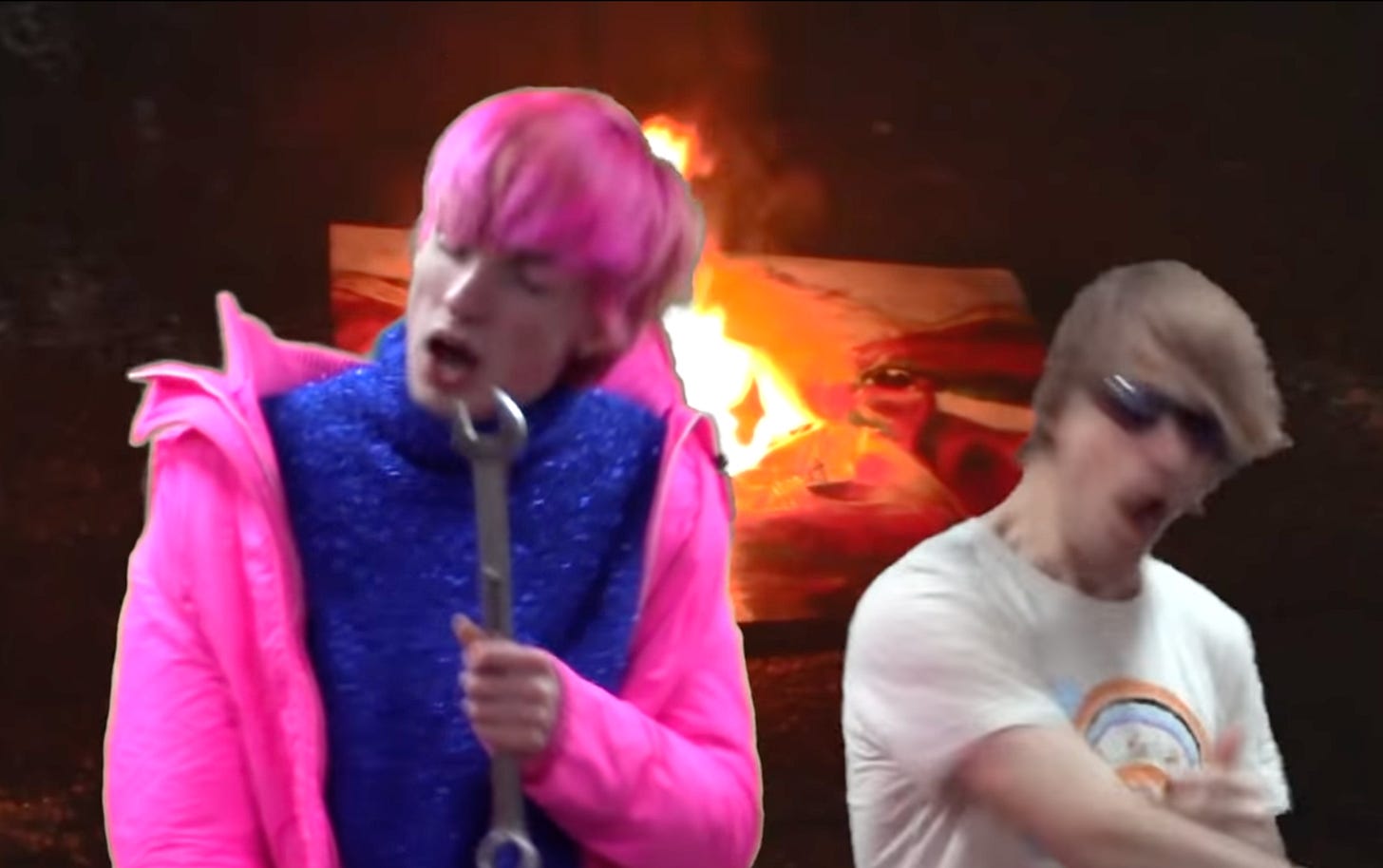
To be honest, the commercial uptake on hyperpop — the time to industry commodification from underground to mainstream — was actually a pretty long tail. Hyperpop has been kicking around for ages; the truth is, nobody wanted it!
Now, back in my day, sonny-boy, we took electroclash from the back-alley discotheques to Fashion Week and Top of the Pops in, like, six months — and we barely had an internet in those days, just a dial-modem, an attitude problem, and a dream…but I digress….
The supposed “mainstreaming” of hyperpop is…why yes, a lot of HYPE. While the influences of hyperpop on the “mainstream” (does such a thing even exist anymore? I do wonder) trickle in here and there (uhhh, that one Camila Cabello song? I guess?), hyperpop really hasn’t exploded commercially.
For all the attention Charli XCX’s Brat brought to the genre, it wasn’t necessarily for its more hyperpop-inspired moments, but rather for more straightforward pop songs like Apple and 360.
Hyperpop’s stark and chaotic soundscapes — along with its obscure, irony-drenched themes and aesthetics — still register as noise and gibberish to most consumers.
And it certainly doesn’t help that the typical hyperpop artist adopts the fashion sensibilities of a nonbinary Juggalo or a transgender MS-13 gangbanger!
Even where some of the genre’s stars have successfully established hyperpop’s existence in the public consciousness, a true crossover moment has remained elusive.
The real reason the audience has felt hyperpop is “dead” is because of a naive belief that subculture3 can be gatekept. Hyperpop is a modern iteration of punk rock’s energy, and as such, tends to view itself as “anti-pop.”
If hyperpop is dead, it died a mimetic death. It choked on its own ironic internet vomit, went out like Sid Vicious.
The recording industry invested a modicum of coin and clout in hyperpop as its audience began to grow during the Lockdown Eras — and the original hyperpop scene kids are just mad that other kids now know what hyperpop is.
Tale as old as time. I tell you wot!
And if “hyperpop is dead,” as is so often the claim, then its corpse is up for grabs. Pop music is in the business of bodysnatching, and don’t you forget it! It’s called the recording industry–it’s based entirely around making money off sounds other people make!
Now, you can imagine how thrilled the would-be gatekeepers of the underground are by the arrival of KATSEYE on their turf.
The K-POP world, stereotypically speaking, is the diametric opposite of hyperpop. Where hyperpop is dissonant and allergic to mainstream attention, K-POP is a self-cannibalizing genre fueled by chart obsessions, fan wars, and algorithmic click-chasing.
K-POP exists as a rigid meritocracy. Its hierarchies are fiercely debated by zealous fandoms. Its stars are often the final survivors of studio camps and televised musical and choreo-bloodsport. This ain’t a scene — it’s a g*ddamn arms race!
KATSEYE, while not formally K-POP, operates squarely in that zone. Their early singles were safe, catchy, audience-approved fluff. Pleasant, better-than-average, but firmly within the boundaries of K-POP’s safe technopop for shimmering shopping malls of the future.
Almost a year after their Summer 2024 debut (it was literally called Debut), KATSEYE 2.0 rolls off the factory assembly line with a quivering thud, a squelching bass, a giggle, a cackle, and a whole lotta gang.
Gnarly is an insane stylistic pivot: angular, aggressive, proudly off-putting.
I cannot emphasize enough how monumental — how audacious — it is for a group like KATSEYE to drop a track like Gnarly.
It’s a big gamble. One that paid off.
How so? Well, for starters, I had never even heard of KATSEYE before Gnarly. Cat’s Eye? I don’t know her. And now I do. That’s huge for them.
The rabid, fanatical (and at times, nuclear) discourse surrounding Gnarly came rumbling onto my timeline via the immediate reaction it garnered from the hyperpop slums of X (where I am known to sometimes loiter4).
While the genres are different, there is also a great deal of audience overlap between K-POP and hyperpop. It was only a matter of time before someone understood this — and realized the potential therein.

Gnarly is both a comeback record and an insanely audacious marketing stunt — and a successful one.
The whole project is channeling full Malcolm McLaren energy: an effortlessly consumable, self-aware, chaotic pop shit-grinning spectacle. It is simultaneously more hyper and more pop than most hyperpop offerings — and the haters are MAD about it!
But Gnarly is far more than just a brilliant public relations maneuver.
Gnarly is a BOP. A BANGER. Gnarly is my JAM.
Gnarly isn’t just weird — it’s WIRED. More than hyperpop — it’s HYPERREAL. And this record isn’t just sublime — it’s SUPER-LIMINAL.
Everything about Gnarly is just so… GNARLY, bruh.

GNARLY’S EVERYTHING
A lot of choices were made to arrive at Gnarly–and one has to imagine all of them required input from dozens, if not hundreds, of businesspeople, producers, marketers, consumer psychologists, freemasons, choreographers, analysts, stylists, satanists and more…plus a terabyte of algorithmic trend data from AI and other assorted robots.
But like the winning girl group in the high-pressure finale of a Korean pop competition–where the losers will be executed on live TV (I didn’t say which Korea🤫) –nobody missed a BEAT.
Every decision made in the making of Gnarly resulted in a pitch-perfect confection. Gnarly is more than a pop song — it is a media machine, a tempest of references, styles, persona, and charm that conjures a spectacle worth far more than the sum of its parts.
Initially, the track’s Dylan Brady-esque stuttering hyperpop beat is relatively generic, and its quirky, spoken-word-style delivery is just esoteric enough to perk the listener’s attention.
As the Diet Gecs beat slonks along, the cartoonish energy of the song percolates and increases (“Now you be like, 'Gang — gang, gang, gang, gang, gang’”).
Gnarly giggles and twerks its way right up to the edge of novelty — when suddenly, and without warning, at 31 seconds in, the track collides with a Eurodance-inspired riff (sounds very KLF-inspired).
That’s when KATSEYE kicks the track into high-octane mode. The substance — the green goo, that real gna-gna-gna-gnarly shit — hits, and everything about this absurd, delightfully pleasing single really takes off.
Important to note: production-wise, KATSEYE is not working with hyperpop names. The track is produced by mainstream K-POP industry titans like Pink Slip (Kyle Buckley), Slow Rabbit, Tim Randolph, and HYBE founder “Hitman” Bang.
Hyperpop purists were upset by the genre’s attempts to take itself upmarket–but the sound was never meant to be gatekept. It’s easy to produce. That’s part of what made it punk.
But ironically, not much is gained by throwing expensive studio technique at hyperpop. The sound doesn’t get better–just glossier.
Nothing about the track, or even the insanely catchy “I’m the sh*t” chorus (??), is all that important on its own. What takes Gnarly to another level is its alchemy–the ultimate synthesis of song, spectacle, and surprise. Gnarly works because it is daring, because nobody expected KATSEYE, or anyone in their lane, to drop a record like it.
The music video is spectacular and splashy, filled with detail, attitude, and humor. It depicts the assembly line of pop production–group members as ingredients, packaged like meat, stacked onto a sandwich. It’s industrial violence reimagined as food styling.
The lyrics feel intentionally placeholder-like, as if written from the POV of Alice Longyu Gao herself–the songwriter and a hyperpop artist with certified classics under her belt. Rich Bitch Juice and Dumb Bitch Juice have never left rotation since the day they dropped. Her signature style is all over Gnarly, and you can hear it.
Gnarly is a corporate pop group song that gleefully usurps underground hyperpop aesthetics. KATSEYE don’t just have their hands in the hyperpop cookie jar–they’re turned on by the thought of getting caught. This is not subtle theft. It’s brazen.
They are joyfully guilty of wholesale appropriation–and they don’t care.
Pop. Art. Legends.
GNARLS DARKLY
The song is aggressively self-referential, mocking the pop writing process and the product: “This song is so lit–congratulations,” sounds like something left on a whiteboard in a writing session. “Making beats for some boring bitch” might even be aimed at themselves. It’s a wink, a smirk, a knife in the ribs.
Through the production of Gnarly–as a song, a music video, and a pop product performed by a prefab girl group on stage and in media–KATSEYE delivers an infectious meta-commentary on culture and meaning itself.
Gnarly is about the production of culture. It’s about how language becomes a product–commodified, manipulated, recycled–and ultimately rendered meaningless.
The word gnarly comes from gnarl, as in twisted wood. Here, it’s used as a cultural stand-in–a word that means everything and nothing. Gnarly is bad… kinda… maybe? Everything’s gnarly, bruh. Boba tea. Tesla. This song??
But Gnarly isn’t “gnarly.” It’s cringe. It’s woke. It’s crashing out. It’s on fleek, so fetch.
Gnarly is making fun of its own mimesis–of the turbocharged way words and concepts race through our language, globally consumed without anyone stopping to consider what they even mean.
If they did, their reaction might be something like Megan’s in the video, when her hands start turning plastic:
“OH MY GOD... IS THIS REAL??”
Gnarly provokes, reacts, and feels alive–the core of pop art. For the great pop artist, there is no “good” or “bad” art. Pop is measured by its impact.
Gnarly doesn’t try to please everyone–and that’s why it works. It’s auto-fellatio punked-up pop mayhem dripping in neon splatter, layers of earworms, and a wicked sort of enthusiasm–a bop by any other name.
Gnarly is the Korean girl from your high school getting drunk for the first time and stealing the vice principal’s car and crashing it into a pool and then laughing about it in an In N Out at 12am because she knows she’s still gonna get into Stanford anyway.
Gnarly has created attention–therefore, it has power. It has power — therefore, it matters.
KATSEYE–and their many suited handlers–have produced a work that embodies a single truth:
Pop is eating itself.
And Eating itself.
And eating itself again.
Until there’s nothing left but the wrapper.
This isn’t the typical oversaturated runoff from the KPOP abattoir.
It’s a ritual pop praxis, a performance of recursion.
A satire and self-fulfilling prophecy of marketing.
A manic, strobing ouroboros of modern culture, that gives KATSEYE an aura and an appeal that differentiates them from the rest of the flock.
What they do with that next is anyone’s guess, but I wouldn’t necessarily bet against them. The Merchants of KATSEYE seem to know exactly what they are doing.
Lets see if KATSEYE can follow up with another hit, which is basically all it would take to push me over the edge and go full EYEKON Gang (Gang gang gang gang).
In the meantime, ladies–this song is so lit. Congratulations.
PS - LOOK AT THESE MOVES!! I MEAN, COME ON
(Actually, Yeezy just dropped the other one, but let’s not go there just now.)
“Daniela Avanzini is. A. Star." –DJ POOLHOUSE (stay around for the credits to peep that Daniela fancam)
For this is the true distinction between subculture and counterculture. No matter how divergent aesthetically a subculture may be, it is always a part of the hegemonic culture, thus always available to be drained into the dominant culture. A counterculture cannot be appropriated easily, because its very being runs antithetical to the hegemonic social structures.
I’m mutuals with slayyyter btw #humblebrag footnote






